
Email Marketing For Restaurants: The Complete Guide for 2025
Every savory meal begins with great ingredients. So do effective restaurant emails. Think of them as a farm-to-table experience. Just like cultivating high-quality ingredients helps you deliver delicious dishes, serving up outstanding email content fosters strong customer relationships.
Email marketing for restaurants is about building a community of food lovers who expect every message similarly to a mouthwatering menu suggestion. To this end, our guide will analyze how to use restaurant emails to nurture existing customers and attract new ones.
More specifically, you’ll find:
- Tips for a successful email marketing strategy
- Email marketing examples for inspiration
- Email templates to use as a starting point
But first, let’s answer an important question: How is email marketing valuable to restaurants?
Restaurant Email Marketing Benefits
What are the main benefits of email marketing campaigns for customers and prospects? Let’s have a look:
Improved Customer Relationships
Email campaigns play a pivotal role in building lasting customer relationships. From transactional emails to limited-time offers, a thought-out email marketing plan keeps diners engaged at different stages in their journey. Using segmentation criteria like dining habits, culinary preferences, reservation or order frequency, you can create personalized promotions and offers.
For example, a post-dining feedback request email shows customers you value their opinions while providing insights to improve your menu and services. For a repeat customer, including an exclusive discount on their next meal is a great way to reward their loyalty. This kind of meaningful and tailored communication paves the way for turning one-time customers into repeat ones.
More Customers And Reservations
The more brand awareness you build, the more likely it is to increase reservations down the line. With the right emails, you can get more new customers at your doorstep, turn them into regulars, and increase the order value.
Here’s how this journey could unfold through a successful email series.
A lead discovers your restaurant online and subscribes to your newsletter. A welcome email with a first-time discount encourages them to make a reservation. After their visit, you send a follow-up email suggesting new menu items based on their last order. Now, if they love steaks, you could recommend a premium cut or a wine pairing for their next visit, leading to a bigger order.
You can also send an email to promote a customer loyalty program, incentivizing VIP customers with exclusive perks
Better Control Over Your Communication
In social media channels like Facebook or Instagram, algorithm updates may cost you part of your audience overnight. In restaurant email marketing, though, you have complete power over your communications. No one controls your email list except you. No platform restrictions affecting your campaign performance, just direct access to your customers.
So, if you have time-sensitive promotions like last-minute table openings, a relevant email will reach your audience exactly when it should without any algorithm burying it. You only need to ensure that you follow best email practices. Some of them include staying compliant with current email regulations and allowing subscribers to opt out or update their email preferences.
Standing Out From Competition
Finally, building an email marketing funnel and consistently engaging with email subscribers helps you stand out. Keep a close eye on how competitors use their email campaigns to nurture their audiences to stay ahead of the curve. Then, you can take it one step further, tailoring your approach to your customers’ habits and likes.
How can you do this? Apart from sending regular offers and updates, share useful and timely resources such as new dishes, limited-time specials, delivery changes, etc. In case you operate in different regions, consider providing location-based content like updates on upcoming events close to your restaurant. You could even collaborate with nearby businesses like a theater and give a discount to diners who show a receipt from that venue.
For example, with this campaign, Chipotle aims to inform its customers about its catering services:
Subject line: 🏈 Big game? We cater. You win.
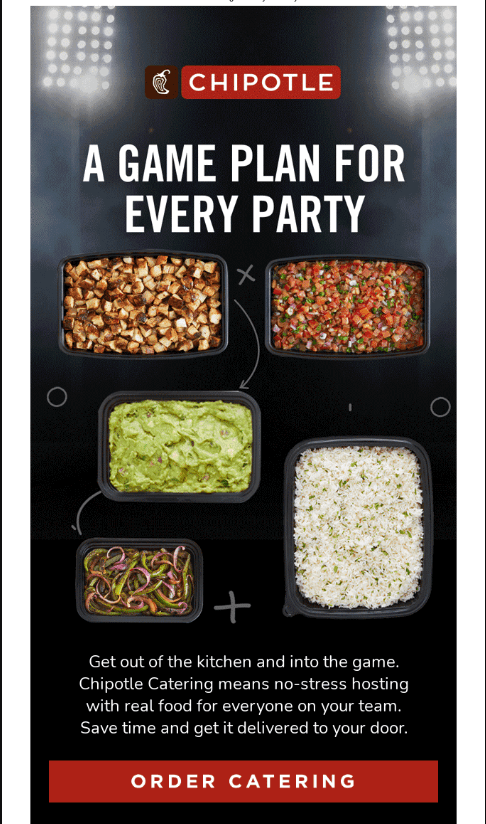
This kind of email communication ensures the brand stays top of mind not only for individual quick meals but also for group orders.
Restaurant Email Marketing Tips
Now let’s go through a step-by-step guide so you can easily set up a top-notch restaurant email marketing strategy.
1. Choose an Email Marketing Platform
When diving into restaurant email marketing, you must put many components together. Conducting everything manually can cost you lots of time and effort. Thankfully, many email marketing platforms offer flexible pricing to help you manage your email marketing campaigns.
From designing visually appealing emails to automating different campaigns, the right email tool should cover your needs and meet your campaign goals. Here are the main features to look for before picking an ESP (Email Service Provider):
- Intuitive dashboard: Manage campaigns in a few clicks.
- Premade templates and drag-and-drop email builder: Design professional emails for seasonal promotions, loyalty perks, review request emails, etc. effortlessly.
- Automation capabilities: Set up popular automated workflows like welcome emails, reservation confirmations, and birthday discounts.
- Robust list segmentation: Send targeted emails to each recipient based on dining frequency, dietary preferences, or favorite dishes.
- Built-in AI features: Craft better emails, landing pages, or subscription forms quickly and suggest tailored menu items with AI-based tools.
- Lead generation options: Grow your email list with eye-catching landing pages and subscription forms.
- Analytics and reporting: Monitor email performance and track metrics like opens, clicks, conversions, etc.
- A/B testing options: Check which subject lines, visuals, CTAs, or offers yield the best results.
Here’s what an easy-to-use dashboard looks like–you can find what you need in a flash without getting lost in the noise:
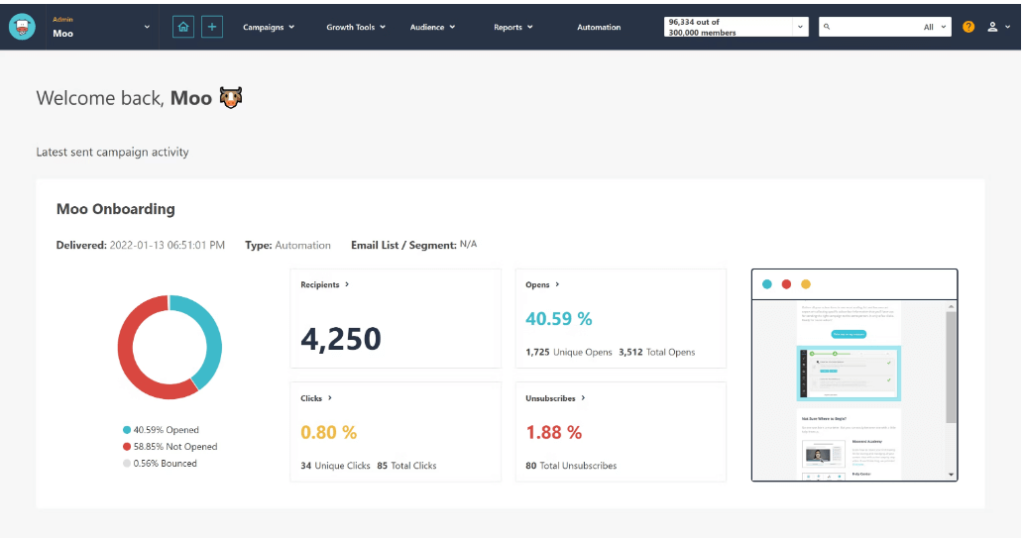
Are you looking for an email marketing service to get started? Read our comprehensive ESP guide and find the perfect platform for your business.
2. Grow Your Email Lists
To send email campaigns to diners, you should create email lists with subscribers who’ve given you permission to email them. But growing these email lists with qualified contacts requires planning and the right tactics. So, how do you attract new subscribers or get loyal customers to join your list?
Let’s see some techniques to grow your email list:
- Embed sign-up forms in key touchpoints: Add pop-up or static subscription forms on your website’s homepage, menu page, or mobile app.
- Collect emails through online reservations: Gather visitors’ email addresses when they book a table online.
- Use menu QR codes: Incorporate QR codes on physical menus, directing guests to your email sign-up page.
- Offer wi-fi sign-ups: Provide free wi-fi during a customer’s stay at your restaurant in exchange for their email address.
- Host giveaway contests: Run contests where users enter by subscribing to your newsletter, using prizes like a free meal.
- Add a sign-up option to social media profiles: Invite social media followers to join your list by including an email sign-up link or button on your profile.
This list is not exhaustive; experiment with creative ways to capture guest interest. Regardless of the method, offering a compelling lead magnet might be the key to more subscriptions. Think of a free dining experience, a downloadable recipe book, or early booking to an event.
Here’s a subscription form from VAGA restaurant to inspire you:
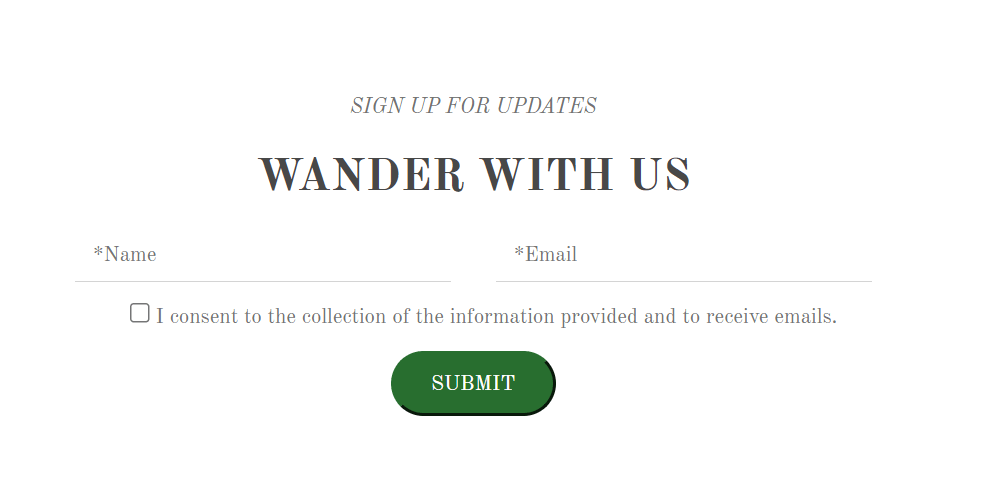
Lastly, to maintain a healthy email list, it’s essential to clean it regularly. That way, you sustain high deliverability and low spam and bounce rates.
3. Use Segmentation and Automation
According to a Salesforce survey, 70% of consumers stay loyal to companies that understand their needs. Email marketing for restaurants offers personalization opportunities to engage customers at every step.
Most email marketing platforms provide audience management features. You divide your audience into groups with common characteristics. Then, you target them with messages that speak to each recipient’s behavior. For example, it’s only natural to target restaurant regulars and occasional visitors with different messages.
There are several segmentation criteria to use. Some of them include:
- Level of engagement, e.g., new, repeat, and inactive customers
- Dietary preferences like vegan and gluten-free
- Ordering habits, such as dine-in vs. takeout customers
Let’s suppose you create a segment for customers who haven’t interacted with your business in the past three months. To win them back, consider sharing the latest menu additions, new delivery options, or an exclusive discount on their next visit. That’s the power of personalized restaurant emails.
Invest in email marketing automation to target subscribers at key moments to ensure timely emails. Email automation comes with benefits you shouldn’t ignore:
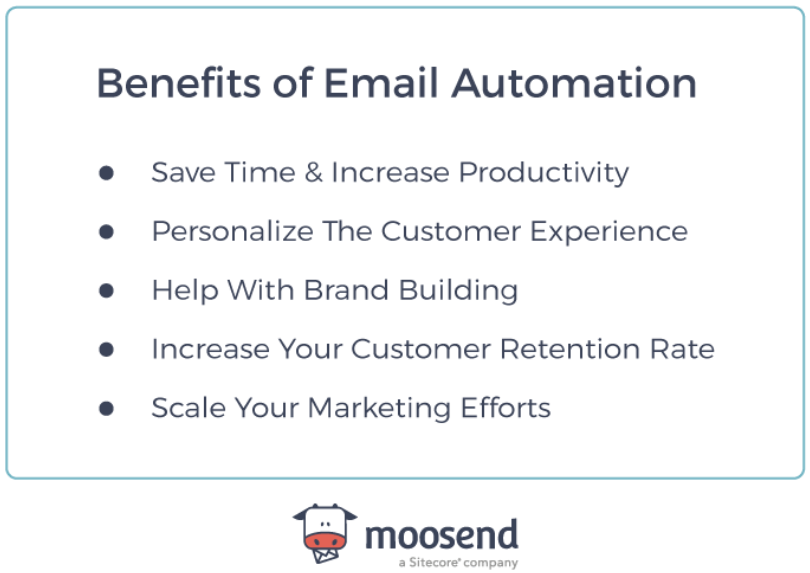
You can set up automated emails triggered by specific behaviors and occasions. For instance, send gift cards to customers on their birthdays or give them a free dessert. Also, you should stay on top of holidays or local events by announcing seasonal menus, extended hours, or last-minute reservation openings.
When targeting loyalty members, automate emails to notify them about expiring points, upcoming rewards, and early access to new products. These are only a few of the must-have automated restaurant emails. Pairing them with detailed segmentation, you offer tailored visitor experiences, farm-to-table style.
4. Design Captivating Email Campaigns
Now it’s time to make magic happen with captivating email design. A great email starts with the company’s logo and goes naturally from one element to another. Including powerful visuals like tasty images of your bestsellers triggers your subscribers’ appetite right from the inbox. It’s preferable to feature your best content above the fold so no reader misses it.
Also, use a strong and prominent call-to-action (CTA) button to direct the reader to your restaurant website or dedicated landing page to take specific action, such as:
- Booking a table
- Checking the menu
- Reading a blog post with cooking tips
- Downloading your app
Finally, place an email footer at the end of the email. There, you can display information about your restaurant, like social media buttons, phone number, and address. These serve as alternative ways for recipients to contact you. And you get more marketing channels to drive customer engagement.
Tip: Add an unsubscribe link to your footer for those who wish to opt out of your restaurant email list. That’s how you ensure your emails only reach interested subscribers.
If your design skills are rusty, you can choose one of the premade email templates of your email platform. Customizing it to your needs and branding is a matter of minutes.
For example, here’s a Moosend template for restaurants to display their menu to customers:
This email template features core elements like the clear headline, the delicious image, and the CTA above the fold. The Z-pattern lets the reader focus on the best-selling items, while there’s a section leading them to explore the blog. Using it as a foundation, you can adjust the content blocks to promote your unique objectives.
5. Write Unique Copy
If your email design is one side of the coin, copywriting is the other. To convince your readers to act, you should write clear and relevant messages that showcase your brand.
The email subject line is one of the most important elements of your newsletter, directly affecting your open rates. Make it short and crisp so it catches the reader’s eye and shows up properly on all devices and email clients.
Always include the main gist of the campaign in your subject. That way, the subscriber knows what to expect. Do you have a limited time offer, new menu item, or special promotion coming up? Or perhaps you want to share a birthday discount. Whatever the case, be sure to mention it in your subject line.
Here are a few subject lines to inspire you:
- Your lunch is ready!
- Our new winter menu is here!
- Up for an exclusive chef’s tasting?
- Craving a delicious mystery tour?
- We got you a little something for your birthday!
- Join us for happy hour today!
Certainly, the preview text and main content must also serve the campaign goal. Preview texts complement the subject line’s message without giving everything away. Once readers click, your email body should deliver on the promise made in these elements. For example, if your subject line teases a birthday gift, show them what they’ll get and offer simple steps to redeem it.
Check the example from McDonald’s below to get in the flow.
Subject line: Your FREE McDonald’s is locked in! 🔒
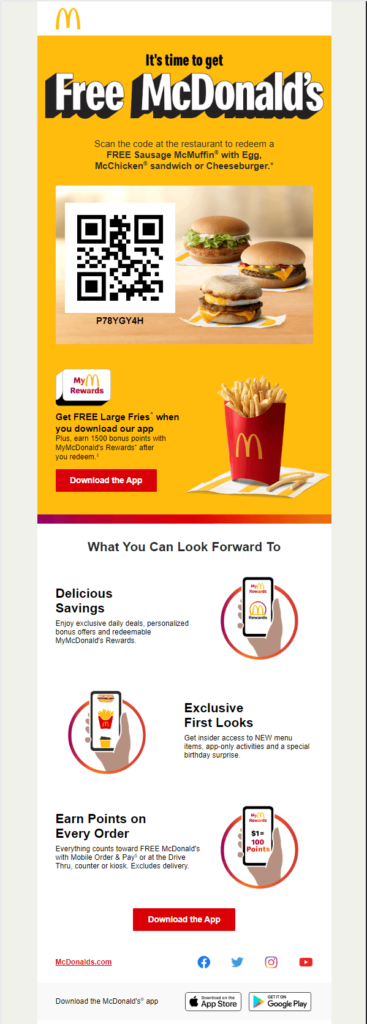
6. Collect Customer Feedback
How will you know your customers enjoyed their experience at your restaurant? The best way is to just ask. Therefore, send automated post-visit or post-order emails to gather valuable feedback directly from diners.
Highlight that you want to hear their insights, including issues they came across. This clarification helps you prove you value their input and want to come closer to their needs. Which, in turn, is key to driving repeat visits.
Why are feedback request emails a powerful tool for restaurants? Here are the main reasons:
- Detecting potential bottlenecks in the customer experience such as slow service or online ordering hiccups
- Reaching out to dissatisfied customers, which gives you a chance to resolve issues before they leave a bad review and turn a negative experience into a positive one
- Building social proof easily with real testimonials that you can later display on your website and social media, influencing prospective customers
In case of a raving review, consider asking subscribers to post their review online. Remove friction points by adding links to review platforms like Yield, TripAdvisor, and Google or directing them to your social media pages. Doing everything directly through your email increases the chances of completion.
Overall, customer feedback is a valuable gift. And it’s usually for free. However, a small reward like a giveaway entry or a free appetizer could sweeten the deal for them. Offering this kind of incentive shows customers you respect their time.
7. Analyze Your Metrics
There’s no magic recipe for creating the perfect restaurant email. Tracking key email marketing metrics and monitoring your performance indicators ensure that the engine is running and that the results you get are the best possible. Plus, they offer valuable data on what to improve.
Below, you’ll find the most important email metrics and recent benchmark data for email marketing for restaurants:
- Open rates: 43.69%
- Click-through rate (CTR): 1.13 %
- Click-to-open rate: 2.93%
- Unsubscribes: 0.17 %
Most email marketing tools offer detailed reporting so you can track which patterns work and which email practices need improvement.
Imagine you send a promotional email for a new seasonal menu, but the open rate is lower than expected. This might indicate that your subject line or preview text is underperforming.
In this case, you should consider a little twist to make it reflect the content. So, instead of “Your favorite dishes got an upgrade,” try “Have an exclusive look at our new summer menu.”
If your click-through rate is suffering, perhaps your CTA feels generic. Consider changing vague messages like “Click here” with easy-to-understand phrasing like “Download the menu.” Another scenario involves making your special offers more personal. Look into customer data to understand which incentive might encourage more clicks.
5 Email Marketing Examples For Restaurants
Now that we’ve explored the best email marketing practices for restaurants, let’s see some amazing campaign examples to help you:
1. Alain Ducasse Exclusive Collaboration Email
Subject Line: Exclusive collaboration with Dom Pérignon
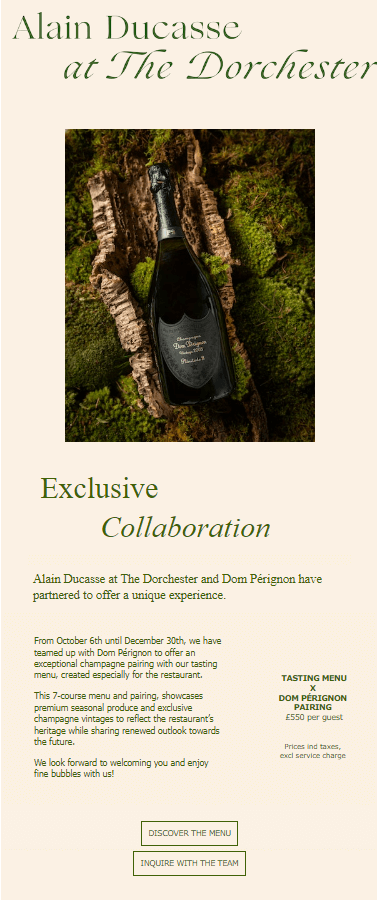
Why it works:
- Alain Ducasse at the Dorchester announces an exclusive collaboration with Dom Pérignon using a classy and plain format.
- The subject line is straightforward and revealing of the content, so subscribers can understand what this campaign is about at first glance.
- The email content is short and includes all the necessary information, from the collaboration dates to the final cost and menu details.
- They include two prominent and straightforward CTAs, one directing readers to discover the menu and another to contact the team for questions.
Want to create a similar campaign? Sign up for a free Moosend account today and use newsletter templates tailored for restaurants.
2. Gibson’s Restaurant Group Welcome Email
Subject Line: Thank you for signing up
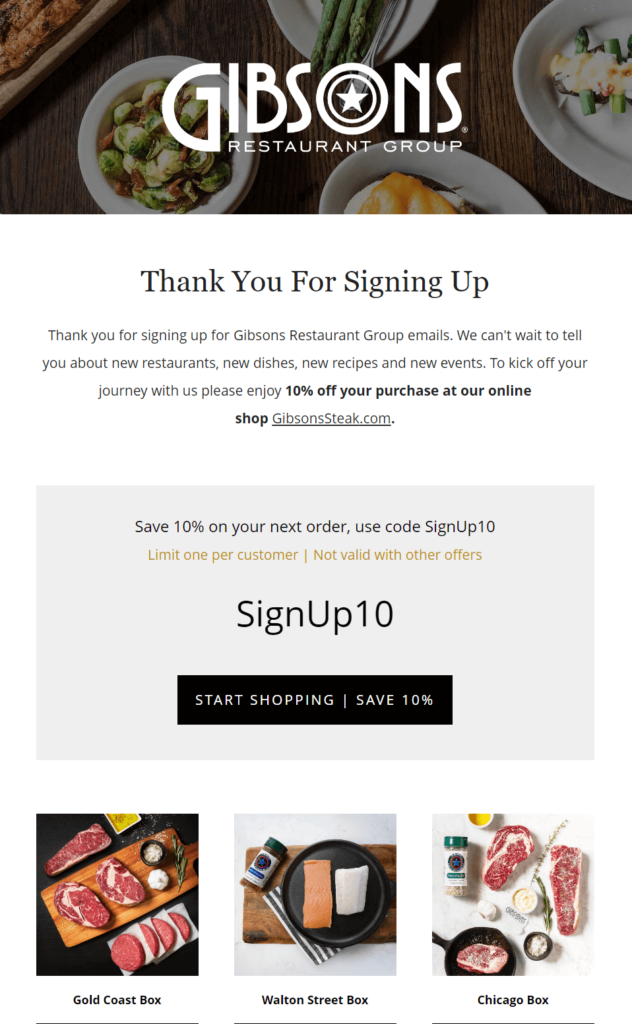
Why it works:
- Gibsons Restaurant Group made the most of this welcome email, thanking new subscribers for signing up.
- They set expectations for future emails, highlighting what subscribers should expect.
- The 10% discount serves as the ideal incentive to prompt new subscribers to visit the restaurant’s online shop and take the desired action.
- They place the CTA and discount code at the center to ensure all readers see and click on them.
- The ample white space allows the reader to focus on the key points, while the high-quality images catch the eye instantly.
3. Bakers Square Birthday Email
Subject Line: Have a free slice on us for your birthday!
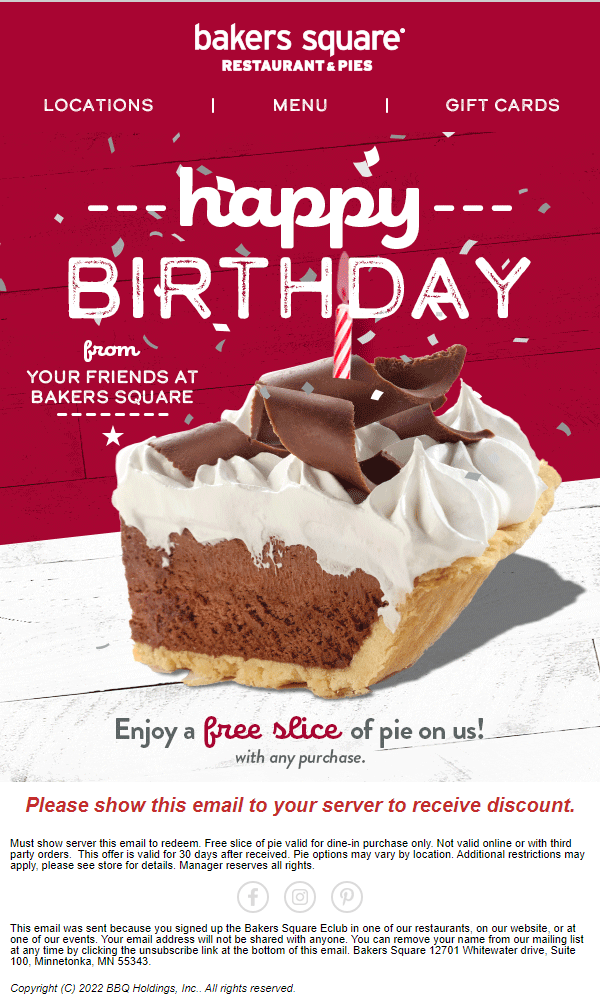
Why it works:
- Bakers Square offers an extra slice of pie for every purchase at the bakery to incentivize recipients to pay a visit.
- The personalized birthday offer makes the recipient feel special and appreciated.
- The email design stands out from the crowd, with intense red color and a yummy piece of birthday cake.
- They included additional options for readers to see the menu, explore locations, and learn about gift cards at the top of the email.
Bakers Square created this unique campaign using Moosend’s editor. Create your version to wish your customers Happy Birthday!
4. Floriana Special Event Announcement
Subject Line: 8 spots left for our Quady North Wine Dinner! 🍷

Why it works:
- Floriana includes the main information about the event, such as the date and time, in the email header.
- They add a sense of urgency starting from the subject line, urging subscribers to hurry up to save one of the last spots—a well-known tactic that capitalizes on the fear of missing out.
- The clever use of vivid red color in the header and CTA grabs attention and creates a natural flow in the email layout.
- The restaurant features the exclusive menu in the email body above the email CTA to inspire action.
5. Restaurant Hub Content Newsletter
Subject Line: #recipient:name#, your ‘Top Fathers Day Restaurant’ picks ⭐

Why it works:
- Restaurant Hub’s email has a clear format, following a logical structure.
- They center the campaign around top recommendations for Father’s Day and helpful resources.
- The repeated use of the bright-colored CTA increases the chances of readers taking the next step.
- The language is simple and actionable, with urgency elements to prompt immediate action.
- They use the recipient’s name in the subject line and the intro, personalizing their approach.
Restaurant Hub used Moosend’s personalization feature to make their communication more direct and personal.
Register for a free account today to give it a try and optimize your email personalization goals.
Email Templates for Restaurants
In restaurant email marketing, email templates are the secret ingredient you need to keep customers engaged. With the right restaurant templates in place, you can easily create an effective and professionally looking campaign—whether it’s a reservation confirmation or a menu update.
Looking for reasons to invest in email templates? Let us help:
- Polished and on-brand look and feel
- Faster email creation
- Easier personalization by tweaking content blocks
- Mobile responsive and well-structured layouts
Moosend and Stripo offer you access to built-in, visually appealing templates that you can fully customize with intuitive drag-and-drop builders. Let’s show you around.
1. The Delivery Food Newsletter Template
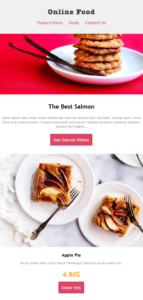
A minimalistic, single-column email layout like this makes your core message stand out while the appetizing visuals in the header grab attention. By adding bold and actionable CTAs throughout the content, you make it simpler for recipients to read through and act. Plus, recipients find options to see the daily menu, contact the business, and check out deals at the top of the email to further engage them.
Moosend’s email template includes just a few elements, which minimizes distractions for readers.
2. The “Simply and Tasty” Promo Template
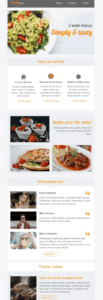
Stripo’s promotional template is attractive and well-structured. You can add your own images displaying your menu’s best items and enticing descriptions to give subscribers an appetite. The structure gives the different elements breathing room. Plus, there’s the clever addition of the customer testimonial section.
Showcasing the reviews of satisfied diners is an effective tactic for any business in the restaurant industry, giving prospects extra reasons to follow your customers’ example.
3. The Valentine’s Dining Template
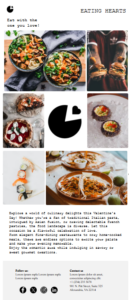
This Valentine’s dining template by Moosend is perfect for engaging subscribers on this special day or any other occasion that resonates with your restaurant and audience. With clear sections and high-quality pictures of multiple dining options, you bring customers one step closer to making a reservation. Benefit from the clean format and white space to highlight your main action. Also, you can use the email footer to encourage subscribers to follow you on social media and provide more contact options with your restaurant.
Want to impress your diners with savory email campaigns? Search Moosend’s restaurant email templates to find the perfect one for the occasion!
Takeaways
If you want to reap the benefits mentioned above, it’s time to streamline your email marketing efforts. Pick an email marketing platform that completes your existing stack and design beautiful restaurant email marketing campaigns to motivate readers to pay you a visit or place an order.
Follow our restaurant best practices for starters and let the email examples and templates shared spark your inspiration. Also, remember to put automated emails and personalization in the game for more consistent restaurant branding, timely and relevant messages, and less manual effort.
Looking for an email tool that other restaurants trust? Sign up for a Moosend account today and enjoy a 30-day free trial.
Email Marketing For Restaurants FAQs
And for dessert, here’s a quick round of frequently asked questions about restaurant email marketing:
1. How can I attract new customers with email marketing?
You can create various emails with offers, discounts, or free resources to motivate them to visit or order.
2. Is email marketing effective for restaurants?
Yes, many restaurant owners use email to warm up customer relationships and increase their ROI over time.
3. How can I grow the email list for my restaurant?
Here are some practices to build your email lists: 1. Subscription forms, 2. Wi-fi sign-ups, 3. Menu QR codes, 4. Online reservations, 5. Giveaway contests, and 6. Sign-up options on social media.
4. How can restaurants market their business online?
These are some prominent digital marketing techniques to focus on: 1. Website optimization, 2. SEO, 3. Email marketing, 4. Social media, and 5. Paid advertising.
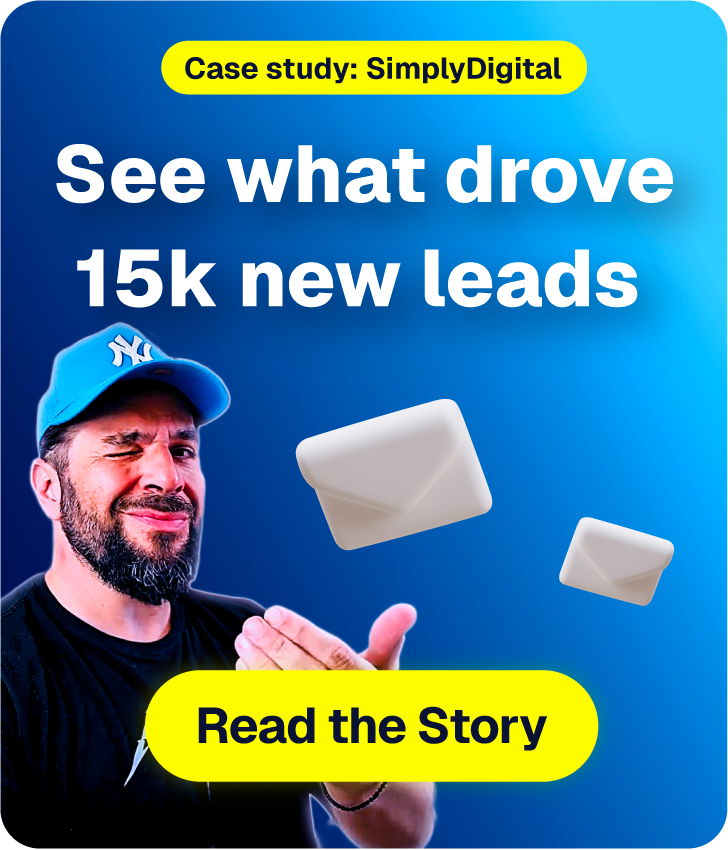
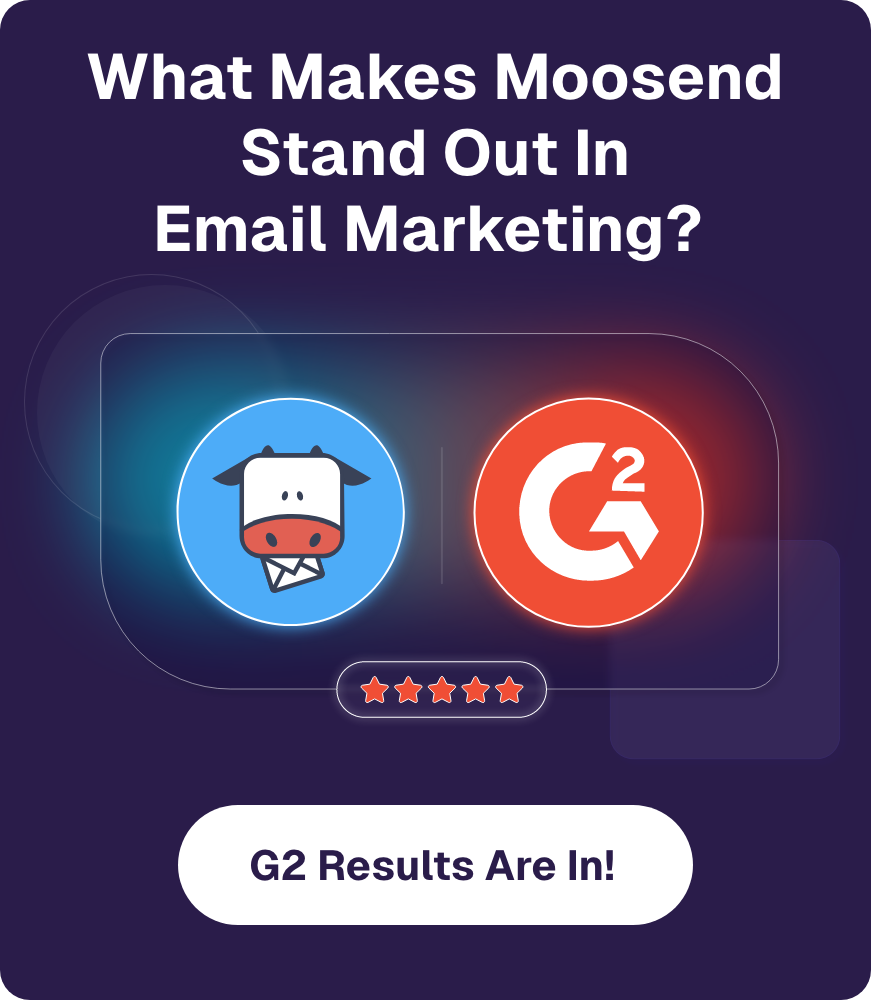

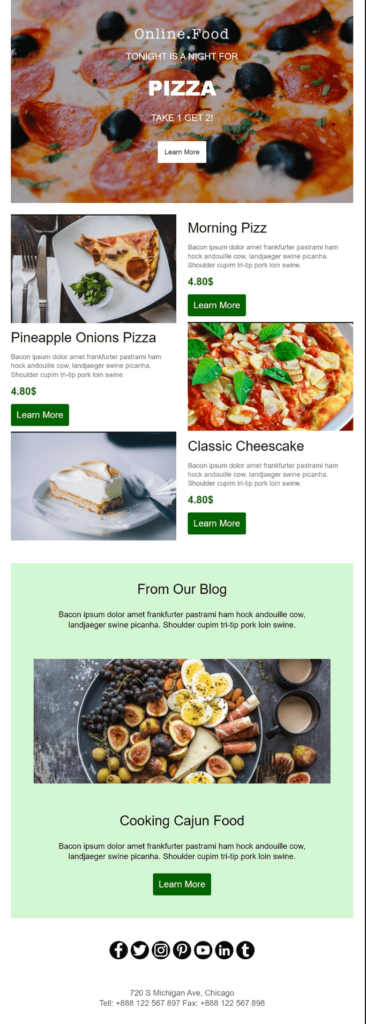
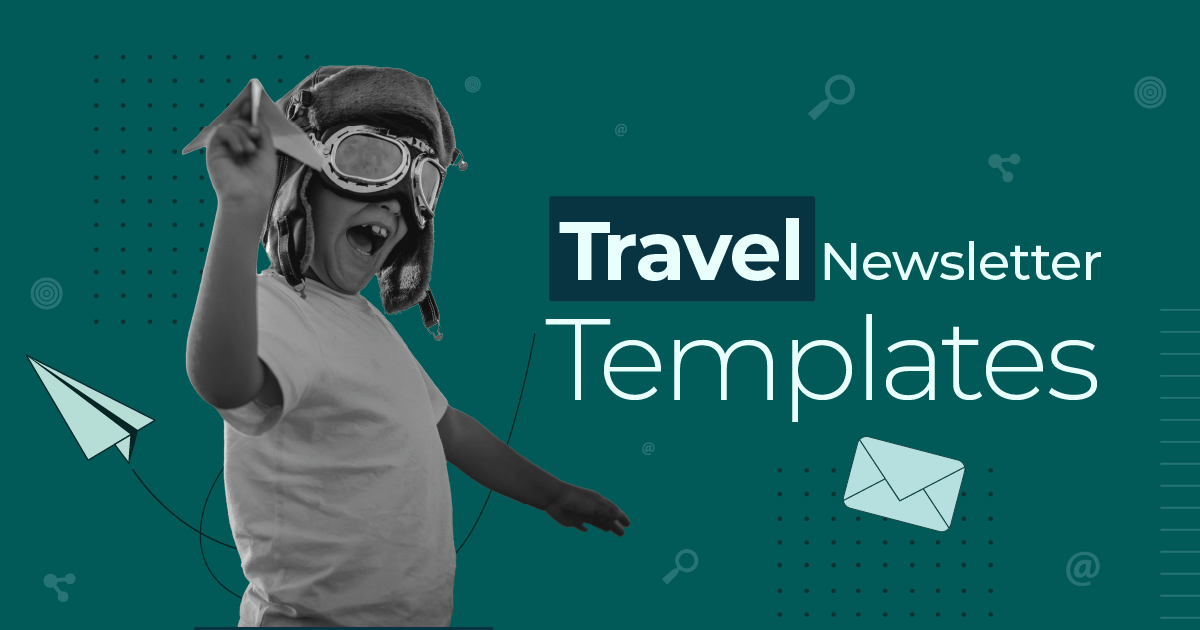
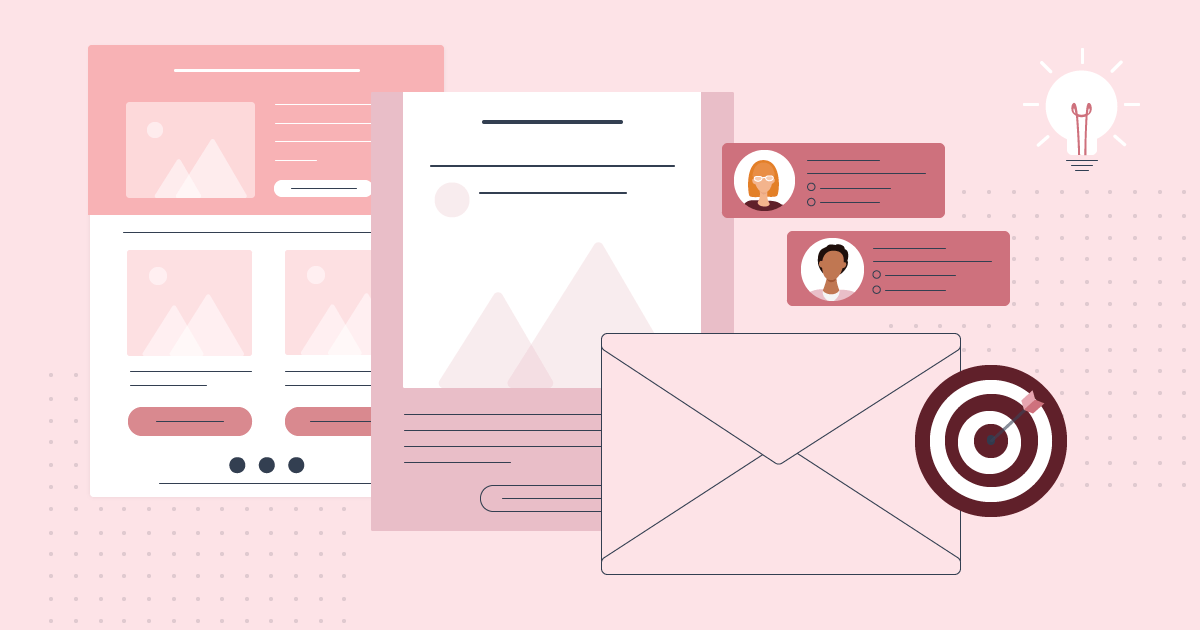
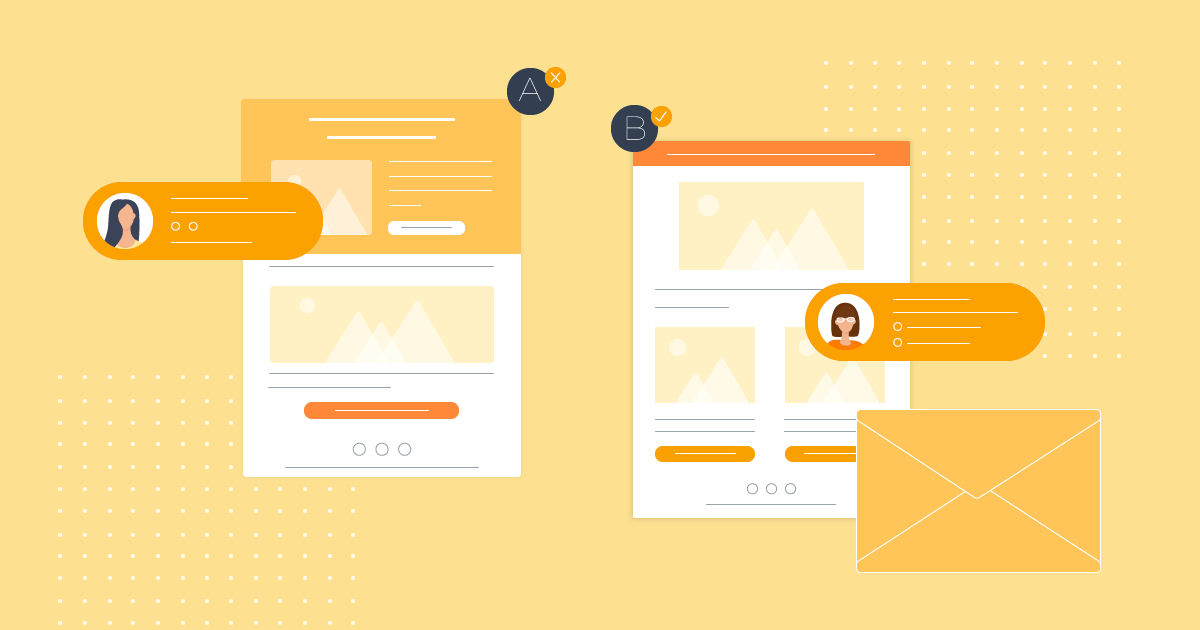
 Published by
Published by